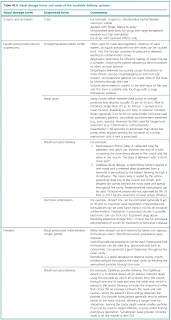Nasal Preparations
Introduction
The intranasal route has been exploited for the management of localized symptoms associated with allergic rhinitis, nasal congestion and nasal infection, as well as for the delivery of drugs to the systemic circulation. In 2019, FDA approves Spravato (esketamine) nasal spray for treatment-resistant depression.
NOTE: Although intranasal drug delivery for systemic activity avoids hepatic first-pass metabolism of oral route and may be associated with rapid absorption and onset of action, it is limited by
- Small delivery volumes, therefore potent drugs are required.
- Mucociliary clearance and/or barrier by mucus decrease absorption of some drugs
- Enzymatic activity (pseudo first-pass effect)
- Low epithelial permeability for hydrophilic drugs; absorption enhances and/or large doses are required.
Drug Delivery
Currently, delivery devices are usually metered-dose manual pump sprays, because they are cheap, robust and reliable, but more sophisticated systems are now under development.
Nasal Spray Counselling
Before use
- Shake the bottle gently and remove the cap.
- Prime the pump before the first use or when you have not used it recently (7-14 days on average).
- Blow your nose to clear your nostrils.
Using the spray
- Close one nostril and insert the nasal applicator into the other nostril, aiming towards the outside wall.
- Start to breathe in through your nose, and press firmly and quickly down once on the applicator to release the spray.
- Breathe out through your mouth.
- Wipe the nasal applicator with a clean tissue and replace cap.
Nasal Decongestants
British Medical Journal experts review in 2018 concluded that over-the-counter decongestant medications should not be used for the treatment of the common cold in children under 6 years of age, and should be used with caution in children aged 6 to 12 years.
- The review found no evidence that decongestants (with or without an antihistamine) alleviate nasal symptoms such as congestion, rhinorrhoea, or sneezing in children. However, there is evidence that they may cause adverse effects such as drowsiness and gastrointestinal upset. More serious harms such as convulsions and rapid heart rate, as well as death, have also been linked to decongestant use in very young children.
- On the other hands, the use of decongestants (with or without an antihistamine or analgesic) in adults for 3 to 7 days if cold symptoms are bothersome is supported; however, the effect is considered small.
Even so, I believed that different physicians are going to have varying opinions on this issue. Regardless, if possible,
- we should reassure the patient that the common cold is self-limiting and that symptoms usually clear in 7 to 10 days.
- It is vital to remind them on the potential risks and counselled them not to use a decongestant spray or drops longer than 7 days (Australian Medicines Handbook suggested no more than five days actually). If not, they will have a rebound congestion (rhinitis medicamentosa).





Comments
Post a Comment